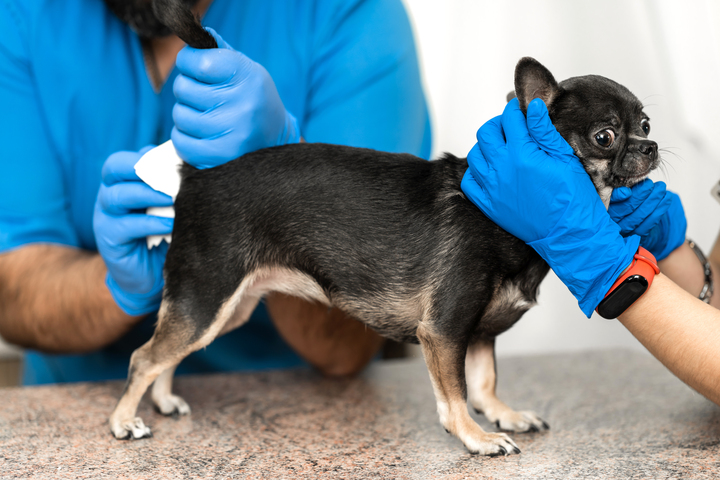Ins and Outs of Anal Sacs

Does your dog regularly scoot its cute backside across the living room floor?
Do you occasionally notice an unpleasant, musky odor in the air or spot a brown streak on the carpet?
Have you noticed your pet obsessively licking its rear end?
If you’ve answered “yes” to any of these questions, your pet’s anal sacs may be to blame.
While not the most exciting topic, knowing what the anal sacs are and how to properly care for them is an important component of your pet’s care.
Form and Function
Anal sacs, also called anal glands, are located just inside both sides of the anus. The lining of the sacs secrete an oily, dark brown, smelly substance that is stored inside the sacs themselves.
Unlike skunks, which can forcefully and voluntarily secrete the contents of their anal sacs, dogs and cats typically express their anal sacs during defecation or when they are nervous or anxious. These odorous secretions are believed to convey information about the pet or serve as territorial markings. Additionally, the oily substance helps lubricate the stool during excretion.
Common Concerns
Impaction of anal sac secretions is the most common cause of anal sac problems in dogs, and sometimes in cats. This occurs when the secretions are not properly expressed during defecation. If left untreated, the sacs will continue to fill and become more impacted, leading to infection and abscesses. This condition is painful for the pet and requires medical treatment to open and drain the abscess. In chronic cases, surgical removal of the anal sacs may be necessary.
Fortunately, most of our pets will make it obvious when they are having anal sac issues. These are the most common signs:
- Scooting the rear end across the floor
- Incessant licking / biting at the rear end
- Having difficulty defecating (or appearing constipated)
- A swollen area surrounding the anus.
The Care and Keeping of Anal Sacs
If you suspect your pet may be having anal sac trouble, contact us at Lone Tree Veterinary Medical Center. Some dogs need to have their anal sacs emptied manually on a regular basis, which requires skill, a gentle touch, and some patience. Since it can be a rather odiferous and messy task for both human and pet, it is a service that we are happy to provide for you.
Here are additional things you can do to help your pet maintain normal functioning anal sacs:
- A change in diet – Adding more fiber to your pet’s diet will create firm, bulky stool that may aid in expressing the anal sacs. Your veterinarian will be happy to provide recommendations for dietary changes.
- A healthy weight – Obese and overweight pets are at higher risk for anal sac problems. Manage your pet’s weight through a high quality diet, portion control, and daily physical activity / exercise.
- Manage skin conditions – Allergic dermatitis and other chronic skin problems can exacerbate anal gland issues. Make sure to follow your veterinarian’s recommendations for proper management of skin and haircoat conditions.
- Regular physical exams – Take your pet to all of its regularly scheduled exam appointments so that anal sac problems can be detected and treated early before they progress and cause further issues.
As always, the team at Lone Tree Veterinary Medical Center is here for you. Please contact us with any questions or concerns you have about your pet’s health and well-being.



